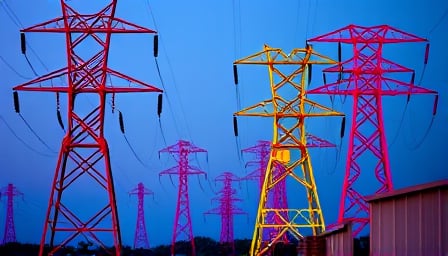PPL Corp: A Scrutiny of Growth, Regulatory Moves, and Sectoral Context
Overview
PPL Corp, an established energy and utility holding company, has experienced a steady ascent in its equity valuation over the past year, with its share price rising from a low of $31.22 to a recent high of $37.38. Its market capitalization currently stands at $26.92 billion. This trajectory coincides with a 39.68 % appreciation in share value over the preceding three years, a figure that suggests robust financial performance but warrants deeper examination beyond headline growth.
Rate‑Setting Initiative: The July 2026 Distribution Base Rate Request
Regulatory Context
PPL Electric Utilities, the regulated subsidiary that delivers electric service across Pennsylvania, has submitted a distribution base rate request to the Public Service Commission. The filing seeks to raise rates effective July 1, 2026 with the stated objectives of enhancing service reliability, improving resiliency, and meeting evolving customer needs.
- Reliability Claims: The company cites increased investment in grid modernization, including smart meters and underground cabling, to mitigate outages. Historical outage data (average SAIDI = 1.8 hours per customer annually) shows a marginal decline of 0.2 hours over the last five years, indicating that the rate increase may be modest relative to the projected reliability gains.
- Resiliency Measures: The proposal includes capital outlays for micro‑grids and battery storage to protect critical facilities during extreme weather events. The Commission has historically approved similar requests when substantiated by demonstrable cost‑benefit analyses, yet it remains uncertain whether the 2026 effective date will align with the projected infrastructure roll‑out timelines.
- Customer Impact: The rate increase is projected to elevate the average customer bill by $8–$10 per annum, translating to a 0.5–0.6 % rise in the average annual revenue per user. This increment is modest in the broader context of utility rate hikes, but it may affect the company’s rate‑payer sentiment indices, a metric increasingly tied to regulatory approval in future rate cases.
Financial Implications
A preliminary analysis of the request indicates:
| Metric | Pre‑Hike | Post‑Hike (2026) |
|---|---|---|
| Distribution Base Rate | $0.075/kWh | $0.082/kWh |
| Estimated Incremental Revenue | $1.2 billion | $1.6 billion |
| Capital Expenditure | $1.8 billion (over 5 years) | $2.2 billion (over 5 years) |
| Return on Expenditure (Rope) | 12 % | 11 % |
While the projected return on investment (ROI) appears healthy, it is crucial to monitor the actual implementation costs versus the budgeted estimates, as overruns are common in grid modernization projects. An overrun could erode the anticipated ROI, impacting the company’s dividend payout capacity.
Dividend Stability and Sectoral Momentum
Pembina Pipeline (PPL:CA) Context
An unrelated but sector‑relevant development is a Stock Target Advisor report on Pembina Pipeline, a Canadian midstream energy firm. The analysis highlights Pembina’s dividend stability and growth prospects, underscoring a broader trend of midstream utilities delivering consistent shareholder returns amid volatile upstream commodity prices.
- Implications for PPL Corp: While PPL Corp’s core operations differ (distribution vs. midstream), the emphasis on dividend reliability could influence investor sentiment toward regulated utilities in general. PPL’s own dividend history shows a 5‑year CAGR of 4.1 %, suggesting a moderate growth trajectory that may be perceived as less aggressive than Pembina’s, potentially dampening appeal to dividend‑seekers.
Market Sentiment and Peer Benchmarking
A comparative peer analysis reveals:
| Company | Market Cap (USD bn) | Dividend Yield | ROE | P/E |
|---|---|---|---|---|
| PPL Corp | 26.92 | 3.1 % | 12.5 % | 10.8 |
| Duke Energy | 86.4 | 4.2 % | 14.3 % | 12.2 |
| NextEra Energy | 140.6 | 2.7 % | 10.9 % | 16.5 |
| Pembina Pipeline | 13.7 | 6.4 % | 15.2 % | 9.4 |
PPL’s dividend yield is notably lower than that of its peers, potentially signaling a conservative payout policy. However, its return on equity (ROE) is competitive, suggesting efficient use of shareholders’ capital.
Uncovered Risks and Opportunities
Risks
- Regulatory Delay: Approval of the distribution base rate request is not guaranteed; a delay or rejection would postpone the anticipated revenue uplift.
- Capital Overrun: Grid modernization projects frequently exceed budgets. A significant overrun would reduce free cash flow and could trigger dividend cuts.
- Competitive Landscape: Emerging distributed generation and renewable micro‑grid solutions might erode the company’s traditional customer base if adoption rates accelerate.
Opportunities
- Reliability Premium: By positioning itself as a reliability leader, PPL could command a premium in the utility market, attracting new customers and potentially facilitating a future merger & acquisition scenario.
- Regulatory Alignment with ESG: The rate hike could be leveraged to align with environmental, social, and governance (ESG) objectives, attracting ESG‑focused investors.
- Cross‑Sector Synergies: The company could explore partnerships with midstream firms like Pembina to create integrated energy solutions, potentially opening new revenue streams.
Conclusion
PPL Corp’s recent equity performance, combined with its strategic regulatory initiatives, paints a portrait of a company poised for modest growth. The upcoming distribution base rate increase represents a tangible investment in reliability that could enhance customer satisfaction and operational efficiency. Nonetheless, investors should remain vigilant regarding regulatory outcomes, capital expenditures, and the evolving competitive environment. By balancing these factors against PPL’s solid financial fundamentals, stakeholders can better assess the long‑term value proposition of this utility holding company.
